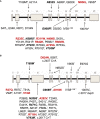The expanding clinical spectrum of autoinflammatory diseases with NOD2 variants: a case series and literature review
- PMID: 38348033
- PMCID: PMC10859468
- DOI: 10.3389/fimmu.2024.1342668
The expanding clinical spectrum of autoinflammatory diseases with NOD2 variants: a case series and literature review
Abstract
Objective: To assess the impact conferred by NOD2 variants on the clinical spectrum of patients with systemic autoinflammatory diseases (SAIDs) in Greece.
Methods: Consecutive patients (n=167) with confirmed SAIDs who underwent screening by next generation sequencing (NGS) targeting 26 SAID-associated genes, and carried at least one NOD2 gene variant, were retrospectively studied. The demographic, clinical and laboratory parameters were recorded.
Results: In total, 24 rare NOD2 variants in 23/167 patients (14%) were detected. Notably, 18 patients had at least one co-existing variant in 13 genes other than NOD2. Nine patients had juvenile- and 14 adult-onset disease. All patients presented with symptoms potentially induced by the NOD2 variants. In particular, the candidate clinical diagnosis was Yao syndrome (YAOS) in 12 patients (7% of the whole SAID cohort). The clinical spectrum of patients with YAOS (mean episode duration 8 days) was fever (n=12/12), articular symptoms (n=8), gastrointestinal symptoms (n=7; abdominal pain/bloating in 7; diarrhea in 4; oral ulcers in 3), serositis (n=7), and rash (n=5), while the inflammatory markers were elevated in all but one patient. Most of these patients showed a poor response to nonsteroidal anti-inflammatory drugs (n=7/9), colchicine (n=6/8) and/or anti-TNF treatment (n=3/4), while a complete response was observed in 6/10 patients receiving steroids and 3/5 on anti-IL1 treatment. Another 8 patients were diagnosed with either FMF (n=6) or PFAPA syndrome (n=2) presenting with prominent diarrhea (n=7), oral ulcers (n=2), periorbital swelling and sicca-like symptoms (n=1), or maculopapular rash (n=1). One patient had a clinically undefined SAID, albeit characterized by oral ulcers and diarrhea. Finally, one patient presented with chronic relapsing urticaria with periorbital edema and inflammatory markers, and another one had a Crohn-like syndrome with good response to anti-IL-1 but refractory to anti-TNF treatment.
Conclusion: NOD2 variants were detected in 1 out of 7 SAID patients and seem to have an impact on disease phenotype and treatment response. Further studies should validate combined molecular and clinical data to better understand these distinct nosological entities.
Keywords: NGS; NOD2; Yao syndrome; coexisting gene variants; systemic autoinflammatory disease.
Copyright © 2024 Karamanakos, Vougiouka, Sapountzi, Venetsanopoulou, Tektonidou, Germenis, Sfikakis and Laskari.
Conflict of interest statement
The authors declare that the research was conducted in the absence of any commercial or financial relationships that could be construed as a potential conflict of interest. The author(s) declared that they were an editorial board member of Frontiers, at the time of submission. This had no impact on the peer review process and the final decision.
Figures




References
Publication types
MeSH terms
Substances
LinkOut - more resources
Full Text Sources
Medical
Molecular Biology Databases

